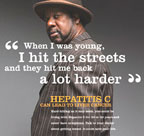
 New hepatitis C treatments have high cure rates for African Americans
New hepatitis C treatments have high cure rates for African Americans
The epidemic of chronic hepatitis C virus (HCV) infection impacts over three million individuals in the United States, and over 50 percent of infected people are undiagnosed. In an effort to increase the number of people who are aware of their HCV infection and link them to care, in 2012 the U.S. Centers for Disease Control and Prevention (CDC) recommended that all persons born from 1945 through 1965 be tested for HCV, given that this group currently accounts for more than 75 percent of adults infected with hepatitis C in the U.S. and are five times more likely to be infected than other adults. Subsequently, in 2013, the U.S. Preventive Services Task Force also recommended a one-time HCV screening for adults born between 1945 and 1965.
Hepatitis C among African Americans
These screening guidelines are especially important for African Americans, a group that is disproportionately affected by HCV infection. An estimated one in 12 African American men born from 1945 through 1965 have been exposed to HCV (Armstrong, et al. 2006). African Americans experience high rates of death due to cirrhosis and liver cancer, often related to chronic HCV infection (Ly, et al. 2014).
However, some people may be reluctant to be tested or seek treatment because of serious and often debilitating side effects associated with the previous standard of care for treating HCV, which included injections of interferon-alfa. Furthermore, interferon-based treatment resulted in cure rates among African Americans that were significantly lower than among Caucasian populations, highlighting the need for new treatment optionsto increase the possibility of cure for all patients.
This blog will summarize the recent rapid advances in HCV treatment that now allow most patients, including African Americans, to be treated and cured without interferon.
HCV treatment history
Pegylated interferon-alfa (Peg-IFN) and ribavirin (RBV) were used to treat genotype 1 HCV from 2002 until 2011. This combination cured about 40 percent to 50 percent of Caucasians, but only 19 percent to 21 percent of African Americans, so there was reluctance among many African American patients to take injections of Peg-IFN, with many difficult side effects, for 48 weeks, with only a one out of five chance of being cured. For years, it was unclear why African Americans did not respond well to interferon. Finally, in 2009, it was discovered that African Americans are much less likely to inherit genes (IL28B polymorphisms) that allow Peg-IFN to work by helping liver cells eliminate the HCV (Ge, et al. 2009). It was clear that in order to improve HCV cure rates for African Americans, alternative treatments would be needed.
New HCV treatments: Faster, better tolerated, higher cure rates for all
The past four years have seen significant advances in HCV treatment, with several new drugs coming to market that can now cure HCV in a shorter period of time and with fewer side effects. The first oral, direct-acting antiviral drugs, tela-previr and boceprevir, were approved by the Food and Drug Administration (FDA) in 2011 and increased cure rates but still required co-administration with Peg-IFN. Clinical trials using boceprevir or telaprevir showed that African Americans had increased cure rates of 53 percent to 62 percent, but these rates were still lower than the 68 percent to 78 percent cure rate seen for Caucasians.





Be the first to comment